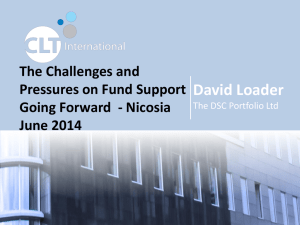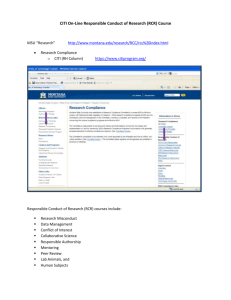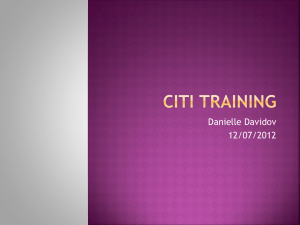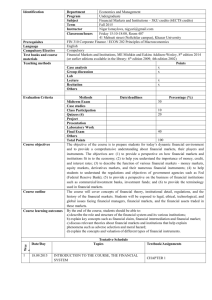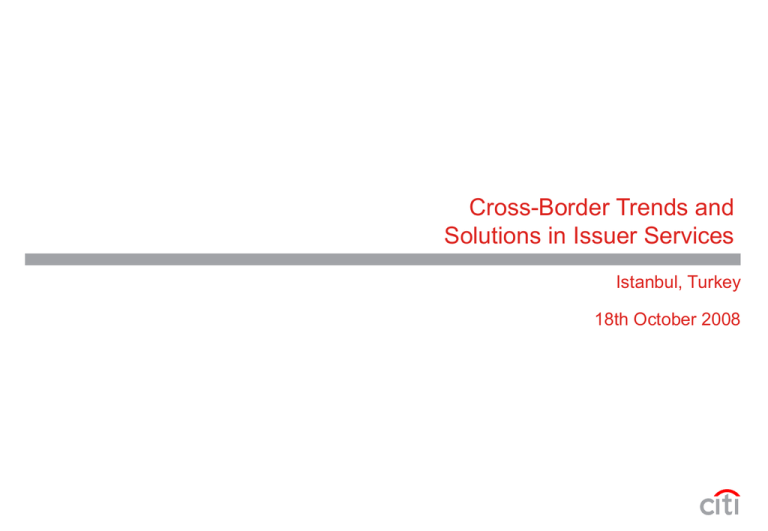
Cross-Border Trends and
Solutions in Issuer Services
Istanbul, Turkey
18th October 2008
Market Update: Different Phases of The Liquidity/Credit Crisis
After a five year period of increased leverage in the financial system, sub prime distress acted as a catalyst for a
broader systemic crisis. We are now in a third phase of massive deleveraging within the banking system.
Precursor
Increase in Leverage in
Financial System 2002 - 2007
Phase 1
Initiation - Sub-prime and
Structured Products Crisis
Phase 2
Illiquidity and Counterparty Risk
Phase 3
Government Intervention
Phase 4
Liquidation / Deleveraging
Balance Sheet Reduction
2
Source: Citi.
Capital Raising
Enormous Liquidity Has Already Been Drained From The System
Availability of liquidity has not only been impacted by absolute writedowns by banks and reductions in regulatory
capital, but also by the associated deleveraging impact.
Estimated Reduction in Credit Availability
Writedowns / De-leveraging
from Banks and Brokers
$5,000 Billion
Banks: ~20x Leverage
Brokers: ~30x Leverage
U.S. Commercial
Paper Market
$500+ Billion
Structured Finance /
ARS Market
$1,000+ Billion
Other
?
Over $6.5 Trillion of Liquidity Drained
from System to Date and More to Come
3 Source: Bloomberg.
Funding Options - Remain Opportunistic and Prepared
In such an environment of heightened competition for liquidity, corporates need to think outside the box and be
prepared to act opportunistically. Corporates will need to take advantage of ad hoc issuance windows and access
markets several times for smaller amounts during this period of financial distress.
Selected Alternative
Sources of Liquidity
Fixed Income
4
Sukuk
Eurobond
Secured Lending
US 144A
US Private Placement
Samurai/EuroYen
AFLAC
Schuldschein
Niche Currencies
Equity
Primary Capital raising
Capital Raised via
Monetisation of non-strategic
stakes in public companies
Both options can be
structured in either the public
markets or privatelynegotiated
Common equity and/or
derivatives solution are
possible structures - DRs
Corporate / Strategic
Actions
Working Capital
Management
Capital Distribution Policies
– Dividend Policy and
Payment Schedule
– Share Repurchase
Program
Asset Sales
Stock-for-stock mergers
Where does Issuer Services fit in a Global Bank?
Global Consumer Group
Global Wealth Management
Institutional Clients Group
Global Cards
Smith Barney
Global Consumer Finance
Citi Private Bank
Global Retail Bank
Citi Investment Research
Markets and Banking
Global Transaction Services
Securities and Fund Services
Issuer Services
- Agency and Trust
- Depositary Receipts
Global and Direct Custody
Securities Finance
Fund Services
Treasury and Trade Solutions
Global Banking
Global Capital Markets
5
Citi Alternative Investments
What does Issuer Services cover in general ?
Issuer Services provides global of corporate trust and agency services.
Issuer Services provides agency and fiduciary services to support the capital market transactions
Dedicated operations, transaction, legal and relationship staff in a number of key locations
Maintains direct electronic links with all major markets: DTC, Euroclear, Clearstream
Acts as a depositary bank for DR programmes and common depository for debt issuance
Supports assets under custody in excess of $4 trillion in debt and equity
Services offered to more than 2,000 corporate, sovereign and SPV clients around the globe
Coverage
London: EMEA (Europe, Middle East and Africa)
London
New York
Dubai: Middle East
Hong Kong
Dubai
Singapore
6
New York: North and Latin America
Singapore & Hong Kong: Asia and Australasia
Issuer Services supports a wide range of financing activities
A broad range of business drivers have resulted in a variety of activities and services.
Business Drivers
Straight Debt
Structured Debt
Instruments
Bonds
Medium Term Notes
Commercial Paper
ABS
MBS
Covered Bonds
Projects of all nature in terms of:
– Domicile
– Industry
– Assets
Mergers
Takeovers
Spin-offs
Loan Facilities
Act as a Loan Facility Agent
Loan Administration
Administers clients investments in loans
Sukuk
Shari’a Compliant Financing
Delegate to the Trustee, Transaction
Administrator, Investment Agent, Paying
Agent, Custodian, Security Agent
ADRs & GDRs
Local DRs
Project Finance
M&A
Loans
Islamic Finance
7
Depository Receipts
Roles
Administrative, fiduciary / fiscal services
associated with the issuance of debt as well
as acting as common depositary
Above roles as well as services specifically
related to the issuance of structured debt,
including securing of assets, asset and cash
flows analysis
Provide services related to the servicing and
securing of assets and cash flows associated
with security packages for project finance
transactions
Manages the tender and exchange process
for large, complex M&A transactions
Depositary Bank, Paying Agent
Overview – Depositary Products / Solutions
A Depositary Receipt (DR) is a negotiable instrument issued by a depositary bank evidencing ownership of shares in
a foreign corporation.
American Depositary Receipts (ADRs) – since 1928
– An ADR represents ownership in the shares of a foreign company trading on US financial markets. ADRs
enable US investors to buy shares in foreign companies without undertaking cross-border transactions
Global Depositary Receipts (GDRs) – since 1990
– GDRs are DRs offered to investors in two or more markets outside the issuer’s home country, usually pursuant
to Rule 144A and Regulation S under the Securities Act of 1933
Local Depositary Receipts – since July 2008
– LDR programs extend the traditional ADR concept to markets globally such as Hong Kong Depositary Receipts
(HDRs)
8
Global Depositary Notes (GDNs) - since 2007
– GDNs offer an alternative way for international investors to invest in a domestic bond; this product is
particularly attractive for countries with currencies that do not settle through the International Clearing
Settlement Depositories
Depositary Receipts – Operational Flows
The core operational services performed are the issuance/cancellation of the DRs, custody of the issuer’s ordinary
shares, processing of dividend payments and other corporate actions, and dissemination of information to the DR
holders.
9
Depositary Receipts – Looking Forward
Looking forward, the Depositary Receipt space may be divided into two categories: Conventional Depositary Receipts
and Local Depositary Receipts.
Conventional Depositary Receipts
Local Depositary Receipts
Components
ADRs (American Depositary Receipts)
GDRs (Global Depositary Receipts)
Hong Kong Depositary Receipts (HDRs), Japanese
Depositary Receipts (JDRs), Indian Depositary
Receipts (IDRs), Singapore Depositary Receipts
(SDRs), Chinese Depositary Receipts (CDRs),
Taiwan Depositary Receipts (TDRs), Brazilian
Depositary Receipts (BDRs)
Year(s) of inception
ADRs: 1927
GDRs: 1992 (Originated by Citi)
BDRs were established in 2002
Exchanges and other
vehicles
NYSE, NASDAQ, Amex, LSE (London), Luxembourg
Stock Exchange, SGX (Singapore), DIFX (Dubai),
Frankfurt Stock Exchange, OTC, PORTAL (144A),
SEAQ (London)
HKEx (Hong Kong), TSE (Tokyo), BSE (Bombay), NSE
(Mumbai), SGX (Singapore), SZSE (Shenzen), SSE
(Shanghai), TSEC (Taiwan), Sao Paulo Stock
Exchange, others to be determined
# of programs
ADR: 1,668, GDR: 570
Total: 2,238
BDR: 9
Current total market
value (September)
$1.8 trillion
BDR: $2.5 billion
Source: Citi DR Universal Issuance Guide
10
All other Local DR programs are in the process of
being established
Depositary Receipts – Trends
The scope and depth of the Depositary Receipt (DR) space has grown significantly over the part several years.
An increasing number of corporations have sought to capitalize on the benefits of a DR program and a growing
number of investors have embraced the DR product as a means to invest globally
– The market value of outstanding DRs is approximately US$1.8 trillion (as of 1H’08), up 38% year-on-year2007 and 50% year-on-year-2006
– DR trading value during 1H’08 was approximately US$2.34 trillion, up 85% year-on-year-2007 and 157%year-on-year 2006
– In 2007, capital in the amount of US$54.8 billion was raised in DR form, up 32% from 2006 and 68% from
2005
– 2,093 DR programs (among 76 countries) currently exist (as of 1H’08), up 4% year-on-year-2007 and 8%
year-on-year-2006
Several stock exchanges are in the process of replicating the models for DR issuance and trading set forth in the
U.S. (American Depositary Receipts—ADRs) and U.K. (Global Depositary Receipts—GDRs) in order to provide
the DR solution to its investor base
– Local Depositary Receipt programs
Source: Citi DR Universal Issuance Guide
11
Conventional Depositary Receipts – Capital Raising
A once ADR-centric solution has become one of virtually equal ADR and GDR issuance.
1. Total Capital Raised in Conventional DR Form (Right)
(USD billions)
2. % Value of Capital Raised in Conventional DR Component (Left)
90%
60
80%
50
70%
60%
40
50%
30
40%
30%
20
20%
10
10%
0%
0
2H'001H'01
2H'011H'02
2H'021H'03
% ADRs
Source: Citi DR Universal Issuance Guide
12
2H'031H'04
2H'041H'05
% GDRs
2H'051H'06
2H'061H'07
Total DRs Issued
2H'071H'08
Why did this trend occur?
– The general rise in prosperity
of non-U.S. markets since
2001
– Sarbanes-Oxley Act (2002)
More cumbersome and
less cost-effective
regulatory requirements for
U.S.-listed companies have
discouraged ADR issuance
GDRs have presented a
more efficient and less
expensive alternative to
U.S.-listed DR programs
– U.S. recession (2001-02)
U.S. investor wallet size
had diminished
Depositary Receipts – Trading Value
By year-end 2007, 5% of the total value of share trading on the DR exchanges was transacted in DRs.
Value of Share Trading
(USD trillions)
60
CAGR = 23%
50
40
30
20
10
CAGR = 37%
0
2003
2004
2005
2006
DR Exchanges
Source: Citi DR Universal Issuance Guide, The World Federation of Exchanges
13
2007
DRs
Proj. 2008
What does this trend signify?
– A general increase in the
value of the DR asset class,
supported by growing demand
among asset managers for
international investment
– Increased use of DRs as a
preferred vehicle for crossborder transacting
– Greater acceptance among
asset managers of the trading
properties of DRs
– The relative deepening of the
DR market versus the broader
market
Depositary Receipts – Capital Raising
By year-end 2007, 20% of all equity capital raising was transacted in DR form.
Capital Raising
(USD billions)
300
CAGR = 18%
250
200
150
100
CAGR = 86%
50
0
2003
2004
2005
DR Exchanges
Source: Citi DR Universal Issuance Guide, The World Federation of Exchanges
14
2006
DRs
2007
What does this trend signify?
– Further evidence of the robust
growth of global issuers
– Greater relative growth of
non-U.S. and non-U.K
companies versus U.S. and
U.K. companies, respectively
The Asia Pacific, Latin
America and CEEMA
regions led the way
– Augmented demand among
asset managers for global
investment vehicles
Local Depositary Receipts
The success of the DR model has led several other stock exchanges & local regulatory bodies to either implement or
take steps to implement proprietary platforms for DR issuance and trading.
This imminent evolution of the DR space coincides with the emergence and/or deepening of liquidity pools in
regions such as MENA
– The engagement of a depositary bank is a necessity
Depositary banks provide stock exchanges with the expertise, experience, infrastructural guidance and
relationships (issuers and investors) required to operate successfully in the DR space
– Global issuers are keen to leverage the attributes of a Local DR program
Facilitate access to fresh liquidity pools for the purpose of executing a capital raise
Function as a vehicle for establishing and/or enhancing corporate visibility within a new marketplace
– The advent of Local DRs broadens the universe of solutions available to local asset managers and other
investors (including retail investors)
Enable portfolio diversification
Provide a more cost-effective and efficient manner in which to invest globally
15
Unsponsored Local Depositary Receipts
Stock exchanges can establish DR programs without direct involvement of the company.
Unsponsored DR programs are set up without the company’s participation or even its consent
Unsponsored DR programs have no regulatory reporting requirements and are issued in accordance with market
demand
Unsponsored shares are typically trade over-the-counter (OTC), but can also be traded on an exchange
– The respective exchange and/or local governing body would establish the regulatory framework
– The depositary implements the DR program based on the regulations
The depositary will provide most of the corporate action services, such as name change, dividend distributions,
etc., except for proxy actions or AGM/EGM
Sample Citi Unsponsored DR Programs
Company
DR Category
Home Country
Nintendo
ADR
Japan
Sharp Corporation
ADR
Japan
Anglo Platinum
ADR
South Africa
Air Liquide
ADR
France
Hutchinson Whampoa
ADR
Hong Kong
Source: Citi DR Universal Issuance Guide
16
Defining Characteristics of Global Depositary Notes
A Global Depositary Note (GDN) is essentially a debt security version of the Depositary Receipt (DR) product.
Global Depositary Notes (GDNs)
– A negotiable instrument issued by a depositary bank evidencing ownership of debt securities (notes) of a
foreign issuer
The underlying instrument is the local currency denominated note
Represent local currency denominated notes replicated in U.S. dollars or another currency
Trade, settle and make payment of interest and principal in U.S. dollars or another currency
Assigned a dedicated debt CUSIP
Can be incorporated as a component of a new issue or an enhancement to an existing one
Generally provide the opportunity to exchange the GDNs for underlying notes and vice versa (“issuance
and cancellation”)
Governed by U.S. law
Typically Rule 144A & Regulation S bifurcated
Local market nature of the product can serve to eliminate requirement of cross-default
Cross-default is prevalent with U.S. dollar denominated global debt
17
Participants in GDN Issuance
GDNs and DRs represent flexible financing tools through which various debt instruments can be wrapped
3
Transaction
Sukuk
–1 The issuer and underwriter
negotiate the terms of the local
Corporate
currency denominated note
Sovereign
offering. The underwriter leads and
coordinates the origination process Supranational
2a Based on investor subscrip!ion to
–
2a
the actual local currency
denominated note offering,
distribution is made to local
investors
Local
–2b Based on investor subscrip!ion to
Investors
the GDN tranche of the note
offering, a matching amount of
actual local currency denominated
notes are deposited with the
custodian
–4 The depositary issues GDNs
versus the local currency
denominated notes held under
custody for distribution to investors
18
Issuer
1
Underwriter
2b
Custodian
3
Depositary
4
GDN Investors
Understanding Islamic Debt Securities
Overview
Geographic Distribution
What is a sukuk?
– Debt-based instruments or financial certificates that are
Shariah compliant
– Comply with Shari’a laws that prohibit the collection of
interest by deriving returns from underlying physical assets
– Issued by governments, banks, and corporate entities
Structure
– 14 different classes of Islamic debt securities
– Common types:
Sukuk al-Ijara
Sukuk al-Musharaka
Sukuk al-Murabahah
Total Issuance in Top Countries, 2000-2007
(US$bn)
Malaysia
UAE
Total Outstanding
Total Issued
Saudi Arabia
Bahrain
Kuwait
0
10
20
30
40
50
60
Total Value of Outstanding Sukuk as of Dec. 2007 = $82.7 bn
Sukuk al-Ijara Structure
Sukuk Holders
(Investors)
2. Issues sukuk to
investors
5. Periodic coupon
payments
1. Sale of assets/title
Seller
(Sovereign/Corporate)
3. Sukuk proceeds
19
Source: International Islamic Financial Market
3. Sukuk
proceeds
Special Purpose
Vehicle (SPV)
4. Lease of assets
5. Periodic rentals and
capital payments
Original Seller or Lessee
(Sovereign/Corporate)
Shari'a Compliant Depositary Receipts
Local DR platforms can provide the opportunity to capture additional capital flows through offering Shari'a compliant
DRs.
The universe of global companies that are considered Shari'a compliant is extensive
– Most established fund companies now offer Shari'a compliant product
– Many exchanges have developed Shari'a compliant indices
DRs enable investors in applicable markets to invest internationally in Shari'a compliant companies
– Many companies that have DR programs sponsored by Citi are considered Shari'a compliant (see examples
below)
These companies are currently components of Shari'a compliant funds or indeces
Company
Exchange
DR Category
Home Country
ABB Limited
NYSE
ADR
Switzerland
BHP Billiton
NYSE
ADR
Australia
Ericsson
NASDAQ
ADR
Sweden
Nestle S.A.
OTC
ADR
Switzerland
Samsung Electronics
London Stock Exchange
GDR
Korea
Tata Motors
NYSE
ADR
India
Source: Citi DR Universal Issuance Guide
20
The Benefits of a Global Depository Sukuk (GDS) Issuance?
A similar structure could be used to wrap a Sukuk into a DR programme
GDS benefits to the markets
•
•
•
Increases international awareness of
and focus on local market and
encourages other issuers in that market
to seek listings
International listings engender
improved perception of quality within
the market
Obligor as
Seller
Rental
Lease
Asset
Purchase Price
Creates view that local market is
flexible and forward looking
Obligor leases
back assets as
Lessee
Sukuk
Certificates
Local
Investors
Issuer
(SPV)
Sukuk
Certificates
Custodian
Depositary
21
Underwriter
GDS
GDS Investors
IRS Circular 230 Disclosure: Citigroup Inc. and its affiliates do not provide tax or legal advice. Any discussion of tax matters in these materials (i) is not intended or written to be used, and cannot be used or
relied upon, by you for the purpose of avoiding any tax penalties and (ii) may have been written in connection with the "promotion or marketing" of any transaction contemplated hereby ("Transaction").
Accordingly, you should seek advice based on your particular circumstances from an independent tax advisor.
Any terms set forth herein are intended for discussion purposes only and are subject to the final terms as set forth in separate definitive written agreements. This presentation is not a commitment to lend, syndicate a
financing, underwrite or purchase securities, or commit capital nor does it obligate us to enter into such a commitment. Nor are we acting in any other capacity as a fiduciary to you. By accepting this presentation, subject to
applicable law or regulation, you agree to keep confidential the existence of and proposed terms for any Transaction.
Prior to entering into any Transaction, you should determine, without reliance upon us or our affiliates, the economic risks and merits (and independently determine that you are able to assume these risks) as well as the legal,
tax and accounting characterizations and consequences of any such Transaction. In this regard, by accepting this presentation, you acknowledge that (a) we are not in the business of providing (and you are not relying on us
for) legal, tax or accounting advice, (b) there may be legal, tax or accounting risks associated with any Transaction, (c) you should receive (and rely on) separate and qualified legal, tax and accounting advice and (d) you
should apprise senior management in your organization as to such legal, tax and accounting advice (and any risks associated with any Transaction) and our disclaimer as to these matters. By acceptance of these materials,
you and we hereby agree that from the commencement of discussions with respect to any Transaction, and notwithstanding any other provision in this presentation, we hereby confirm that no participant in any Transaction
shall be limited from disclosing the U.S. tax treatment or U.S. tax structure of such Transaction.
We are required to obtain, verify and record certain information that identifies each entity that enters into a formal business relationship with us. We will ask for your complete name, street address, and taxpayer ID number.
We may also request corporate formation documents, or other forms of identification, to verify information provided.
Any prices or levels contained herein are preliminary and indicative only and do not represent bids or offers. These indications are provided solely for your information and consideration, are subject to change at any time
without notice and are not intended as a solicitation with respect to the purchase or sale of any instrument. The information contained in this presentation may include results of analyses from a quantitative model which
represent potential future events that may or may not be realized, and is not a complete analysis of every material fact representing any product. Any estimates included herein constitute our judgment as of the date hereof
and are subject to change without any notice. We and/or our affiliates may make a market in these instruments for our customers and for our own account. Accordingly, we may have a position in any such instrument at any
time.
Although this material may contain publicly available information about Citi corporate bond research, fixed income strategy or economic and market analysis, Citi policy (i) prohibits employees from offering, directly or
indirectly, a favorable or negative research opinion or offering to change an opinion as consideration or inducement for the receipt of business or for compensation and (ii) prohibits analysts from being compensated for
specific recommendations or views contained in research reports. So as to reduce the potential for conflicts of interest, as well as to reduce any appearance of conflicts of interest, Citi has enacted policies and procedures
designed to limit communications between its investment banking and research personnel to specifically prescribed circumstances.
[TRADEMARK SIGNOFF: add the appropriate signoff for the relevant legal vehicle]
© 2008 Citigroup Global Markets Inc.
the world.
Member SIPC.
All rights reserved. Citi and Citi and Arc Design are trademarks and service marks of Citigroup Inc. or its affiliates and are used and registered throughout
© 2008 Citigroup Global Markets Limited. Authorized and regulated by the Financial Services Authority. All rights reserved. Citi and Citi and Arc Design are trademarks and service marks of Citigroup Inc. or its affiliates and are used
and registered throughout the world.
© 2008 Citibank, N.A. All rights reserved. Citi and Citi and Arc Design are trademarks and service marks of Citigroup Inc. or its affiliates and are used and registered throughout the world.
© 2008 Citigroup Inc. All rights reserved. Citi and Citi and Arc Design are trademarks and service marks of Citigroup Inc. or its affiliates and are used and registered throughout the world.
© 2008 [Name of Legal Vehicle] [Name of regulatory body.] All rights reserved. Citi and Citi and Arc Design are trademarks and service marks of Citigroup Inc. or its affiliates and are used and registered throughout the world.
In January 2007, Citi released a Climate Change Position Statement, the first US financial institution to do so. As a sustainability leader in the financial sector, Citi has taken concrete steps to address this important issue of climate
change by: (a) targeting $50 billion over 10 years to address global climate change: includes significant increases in investment and financing of alternative energy, clean technology, and other carbon-emission reduction activities; (b)
committing to reduce GHG emissions of all Citi owned and leased properties around the world by 10% by 2011; (c) purchasing more than 52,000 MWh of green (carbon neutral) power for our operations in 2006; (d) creating
Sustainable Development Investments (SDI) that makes private equity investments in renewable energy and clean technologies; (e) providing lending and investing services to clients for renewable energy development and projects; (f)
producing equity research related to climate issues that helps to inform investors on risks and opportunities associated with the issue; and (g) engaging with a broad range of stakeholders on the issue of climate change to help advance
understanding and solutions.
Citi works with its clients in greenhouse gas intensive industries to evaluate emerging risks from climate change and, where appropriate, to mitigate those risks.
efficiency, renewable energy & mitigation

